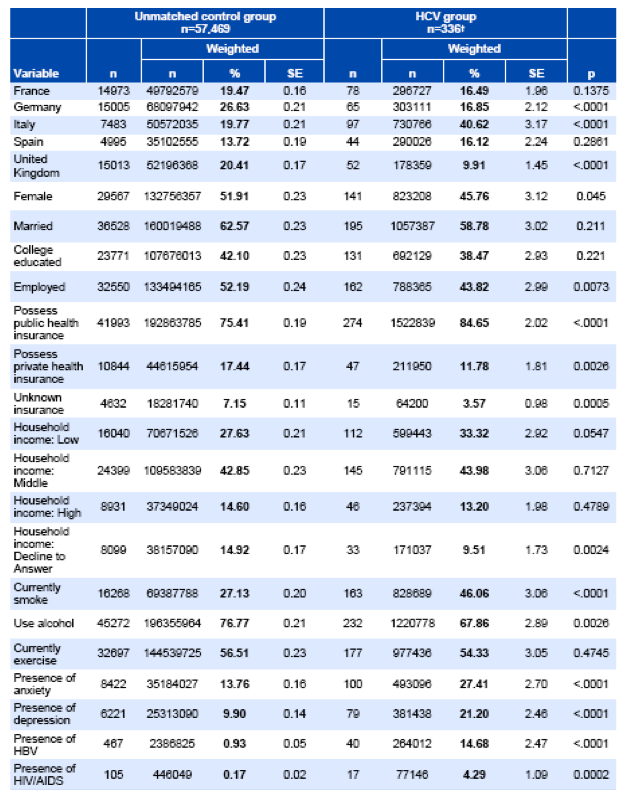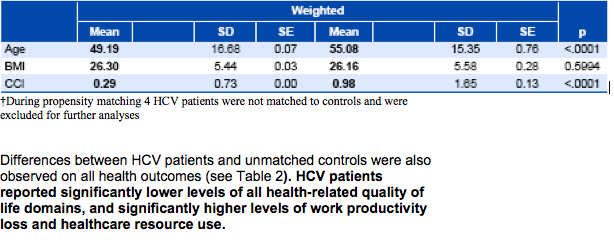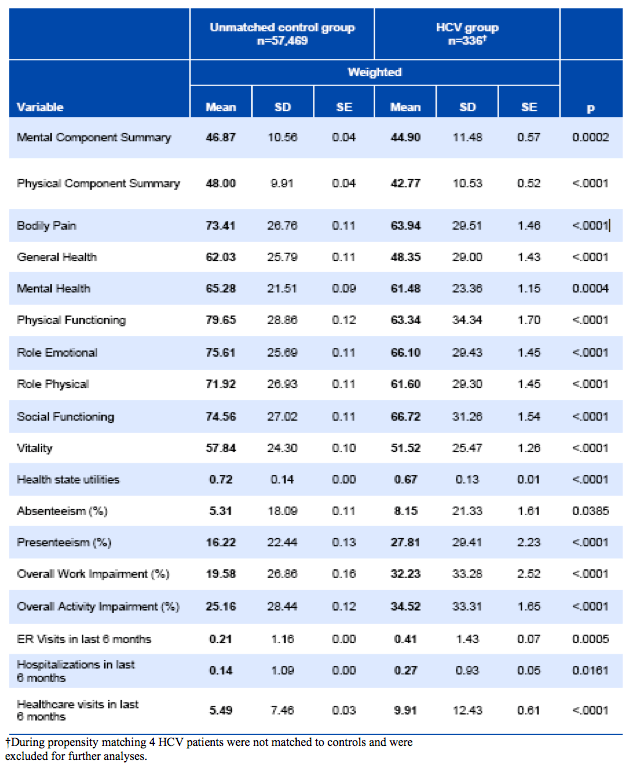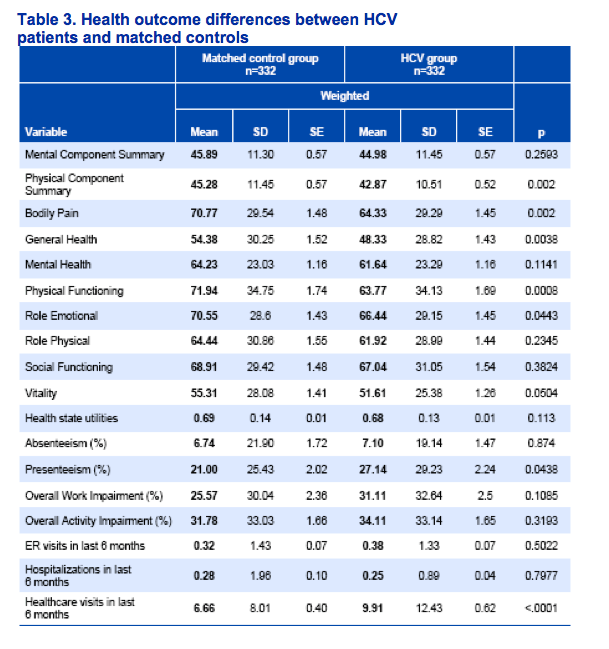 |
 |
 |
| |
Burden of viral hepatitis C in Europe: a propensity analysis of patient outcomes
|
| |
| |
Reported by Jules Levin EASL 2011 Berlin Germany March 30-Apr 2
Marco daCosta DiBonaventura, PhD1; Yong Yuan, PhD2; Jan-Samuel Wagner1; Gilbert J. L'Italien, PhD2,3; Phil McEwan, PhD4; Paul Langley, PhD5;
1Health Sciences Practice, Kantar Health, NY; 2Global Health Economcis and Outcomes Research, Bristol-Myers Squibb, NJ; 3Yale University School of Medicine, CT; 4Swansea University, Wales; 5College of Pharmacy, University of Minnesota, MN
AUTHOR CONCLUSIONS
The prevalence figures found here were lower than previous estimates1. However, the current results were relationally consistent with previous estimates, such that the Italy and Spain had higher prevalence estimates of HCV than France, Germany, and the UK.
As found elsewhere, HBV and HIV were found to be significantly more prevalent among HCV patients than the general population.
The results suggest the presence of HCV is associated with detriments in quality of life and increased levels of work productivity loss and healthcare resource use among the adult EU population.
These analyses accounted for an exhaustive array of demographic and health history characteristics which are known to burden the HCV population and be associated with health outcomes.
In sum, there is evidence that HCV places a substantial burden on the adult EU population.
ABSTRACT
Background: Viral hepatitis C (HCV) affects 170 million patients worldwide with prevalence rates estimated at 1 percent across Europe. The objective of the current study is to examine the burden of HCV in EU from a patient perspective.
Methods: Using data from the 2010 EU National Health and Wellness Survey (which included UK, France, Germany, Italy, and Spain), patients who reported a HCV diagnosis (n=332) were compared to a propensity-score matched non-HCV control group (n=332) on measures of quality of life (using the SF-12v2), work productivity (WPAI questionnaire), and healthcare resource use in the past six months. All analyses applied sampling weights to project to the respective country populations.
Results: Prior to matching, HCV patients reported significantly lower levels of all health-related quality of life domains, higher levels of work productivity loss, and greater healthcare resource use (all ps<.05). The propensity matching process eliminated differences between the two groups on almost all demographic, health risk behavior, and comorbidity variables (rates of HBV being the lone exception). Post-match HCV patients reported significantly lower levels of several health-related quality of life domains (including PCS scores: 42.87 vs. 45.28, p<.05) than matched controls. HCV patients also reported a significantly higher percentage of impairment while at work (presenteeism; 27.14% vs. 21.00%, p<.05) and significantly more healthcare visits in the past six months (9.91 vs. 6.66, p<.05) than matched controls. A sensitivity analysis (controlling for differences in HBV post match) replicated these effects.
Conclusions: These results are similar to previous studies conducted using the U.S. and Japan NHWS databases. The results suggest the presence of HCV is associated with detriments in quality of life and increased levels of work productivity loss and healthcare resource use among the adult EU population.
*Due to a correction in the CCI calculation (HCV was originally kept as part of the CCI calculation, though it should have been excluded), the results in the poster differ slightly from the submitted abstract.
Background
Between 1.1 and 1.3% of the European region population is infected with HCV1. Some areas, such as central and southern Italy, are considered to be hyperendemic2.
While HCV is considered to be a public health issue in Europe due to HCV-related liver disease3-5, little is known about its effect on health-related quality of life, resource utilization and work productivity in the region.
Indeed, little evidence quantifying the burden of disease is available, especially in which a standard methodology is used from country to country1.
The current study seeks to assess the effect of HCV on health-related quality of life, resource utilization, and work productivity among nationally-representative samples of individuals from France, Germany, Italy, Spain and the United Kingdom.



After applying sampling weights to generalize to the respective national populations, patients with HCV were more likely to be male (48.19% vs. 54.24%), unemployed (47.81 vs. 56.18), possess public health insurance (75.41% vs. 84.65%), currently smoke (27.13% vs. 46.06%) and were less likely to possess private insurance (17.44% vs. 11.78%) and to consume alcohol (76.77% vs. 67.86%) (all ps<.05; see Table 1).
Hepatitis B virus (HBV) (0.93% vs. 16.68%), and human immunodeficiency virus (HIV) (0.17% vs. 4.29%), were more prevalent among the HCV group. HCV patients also reported significantly higher CCI scores (0.98 vs. 0.29) (all ps<.05).
Table 1. Demographics and health history differences between HCV patients and
unmatched controls


Post-matching, HCV patients were equivalent to matched controls on country of residence, gender, age, maritalstatus, education, household income, employment status, insurance coverage, tobacco smoking, alcohol consumption, body mass index (BMI), physical exercise, and CCI scores (all ps>.05).
- HCV patients did reported significantly higher rates of HBV than matched controls after the matching process (7.20% vs. 3.41%, p<.05).
HCV patients reported significantly lower levels of several health-related quality of life domains (including PCS scores: 42.87 vs. 45.28, p<.05) than matched controls (see Table 3).
HCV patients also reported a significantly higher percentage of impairment while at work (presenteeism; 27.14% vs. 21.00%, p<.05) and significantly more healthcare visits in the past six months (9.91 vs. 6.66, p<.05) than matched controls.

References
1. Muhlberger, N., R. Schwarzer, et al. (2009). "HCV-related burden of disease in Europe: a systematic assessment of incidence, prevalence, morbidity, and mortality." BMC Public Health 9: 34.
2. Ansaldi, F., B. Bruzzone, et al. (2005). "Different seroprevalence and molecular epidemiology patterns of hepatitis C virus infection in Italy." J Med Virol 76(3): 327-332.
3. Garcia-Fulgueiras, A., R. Garcia-Pina, et al. (2009). "Hepatitis C and hepatitis B-related mortality in Spain." Eur J Gastroenterol Hepatol 21(8): 895-901.
4. McAvoy, N. C. and P. C. Hayes (2007). "The cirrhosis epidemic in the UK: evaluating the causes in a European context." Expert Rev Gastroenterol Hepatol 1(1): 41-45.
5. Sagnelli, E., T. Stroffolini, et al. (2005). "The importance of HCV on the burden of chronic liver disease in Italy: a multicenter prevalence study of 9,997 cases." J Med Virol 75(4): 522-527.
6. Parsons LS. (2004). "Reducing bias in a propensity score matched-pair sample using greedy matching techniques." Proceedings of the Twenty-Six Annual SAS_Users Group International Conference, Cary, NC: SAS Institute Inc. 214-26.
|
| |
|
 |
 |
|
|